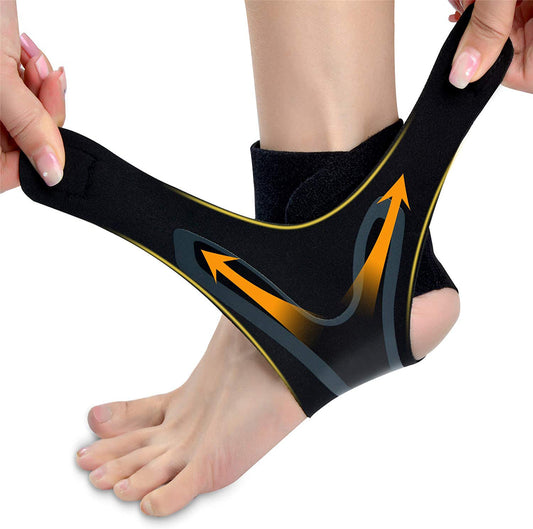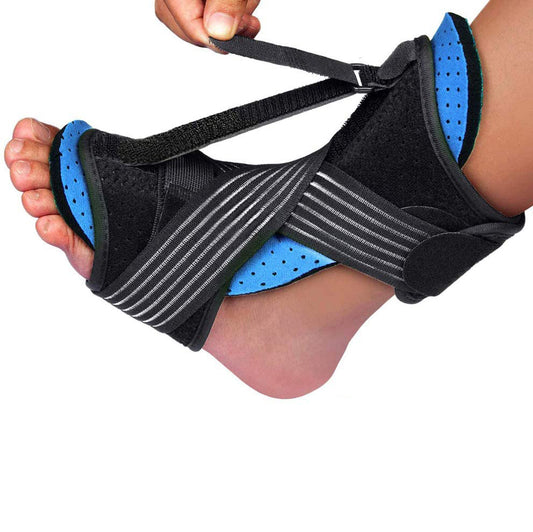-
Ankle Support Brace, Adjustable Ankle Brace with Breathable & Elastic Nylon Material, Comfortable Ankle Wrap Sports Protect Against Chronic Ankle Strain Sprains Fatigue
Regular price $13.99 USDRegular price$23.99 USDSale price $13.99 USDSale -
Ankle Brace, Lace Up Adjustable Support – for Running, Basketball, Injury Recovery, Sprain! Ankle Wrap for Men Women
Regular price $21.99 USDRegular price$21.99 USDSale price $21.99 USD -
Ankle Support Brace, Breathable Neoprene Sleeve, Adjustable Wrap
Regular price $15.99 USDRegular price$15.99 USDSale price $15.99 USD -
New Upgraded Night Splint for Plantar Fasciitis, Breathable and Adjustable Sleep Support Foot Drop Orthotic Brace for Plantar Fasciitis, Arch Foot Pain, Achilles Tendonitis Support for Women, Men
Regular price $32.99 USDRegular price$56.00 USDSale price $32.99 USDSale
Collection: Ankle Foot Orthosis for Support and Recovery
Discover Our Comprehensive Collection of Ankle Foot Orthosis (AFO) Solutions
Ankle Foot Orthoses (AFO) are pivotal in providing stability and mobility assistance to those who need it. At ZSZBACE, with years of experience in research and development, we provide precisely manufactured AFOs designed to serve diverse individual needs and enhance daily life. Our dedication to quality and service ensures our customers receive only the finest products and support.
What is an Ankle Foot Orthosis (AFO)?
An Ankle Foot Orthosis is a custom leg brace designed to stabilize the foot and ankle, maintaining optimal positioning for standing and walking. These devices control the range of motion and are tailored to meet unique individual requirements. AFOs can be hinged for movement or fixed for stability and may be worn on one or both feet.
Who Needs Ankle Foot Orthosis?
Identifying the Need for AFO
AFOs are beneficial for:
- Individuals experiencing muscle weakness.
- Those with conditions leading to foot drop or instability.
- Patients recovering from stroke or neurological conditions.
- Persons with chronic foot and ankle pain.
Why Use an Ankle Foot Orthosis?
AFOs provide several vital benefits:
- Ease of Walking: These devices make ambulation more efficient and reduce fatigue.
- Improved Positioning: AFOs help align the feet and ankles correctly.
- Muscle Support: They offer critical support to weakened muscles, minimizing strain and injury risk.
- Safety: Reducing the likelihood of falls by stabilizing the user.
- Pain Alleviation: By correcting posture and distributing weight, AFOs alleviate discomfort.
How to Determine Suitability for AFO
- Consultation with Healthcare Professionals: It is essential to discuss with an orthopedic specialist who can recommend the correct type of AFO.
- Symptom Evaluation: Persistent ankle weaknesses, balance challenges, and specific gait problems may signify the need for AFOs.
Explore our wide range of Ankle Support Braces that cater to various needs.
Characteristics of AFOs
- Customization: Tailored to fit the specific requirements of the user’s lifestyle and condition.
- Durable Materials: Constructed using high-quality, breathable, and elastic materials for maximum comfort.
- Convenience: Designed for easy application and adjustment without compromising support.
Frequently Asked Questions
What Shoes and Clothing Should Be Worn with an AFO?
To prevent direct skin contact, it is recommended to wear cotton socks or tights. Shoes should adequately accommodate the AFO, often requiring larger sizes or custom options with removable soles. Laced or Velcro-fastened shoes are ideal, while slip-ons and slingbacks are unsuitable.
Browse our breathable neoprene ankle wraps for additional support and comfort.
How to Properly Wear an AFO
- Sit with hips and knees bent at 90°.
- Ensure your socks are creaseless, pulling them up securely.
- Place your heel firmly against the AFO's back and fasten the ankle strap (secure but not too tight).
- Adjust the top strap for snugness.
- Finally, wear suitable shoes while using the AFO.
How Long Should an AFO Be Worn?
It might take time to adjust to wearing an AFO. Gradually increase wear time following a structured schedule provided by your orthotist, beginning with shorter durations and extending to full-day use as needed.
- Day 1: 30-60 minutes
- Day 2-3: 1-4 hours
- Week 1: 4-6 hours, increasing with comfort.
View our adjustable ankle supports fit for daily wear and various activities.
Ankle Foot Orthosis Care
- Cleaning: Clean with a damp cloth. Pads and straps may discolor but remain effective.
- Heat Exposure: Avoid direct heat sources. Air dry after cleaning.
- Daily Checks: Inspect for any signs of damage. Ensure all fasteners are secure and in working order.
- Professional Maintenance: Do not attempt repairs alone; consult your orthotist for adjustments or if you detect damage.
Conclusion
At ZSZBACE, we offer a wide range of Ankle Foot Orthoses to meet distinct requirements and improve the quality of life. Our commitment to quality, customer service, and innovation in product development ensures our customers benefit from advanced solutions for their mobility needs.
By visiting our collection of ankle support products, customers can explore options like the Lace Up Adjustable Support, emphasizing comfort and reliability. Our products, detailed in design and manufactured with premier materials, serve as a crucial part of the recovery and support journey for many.




